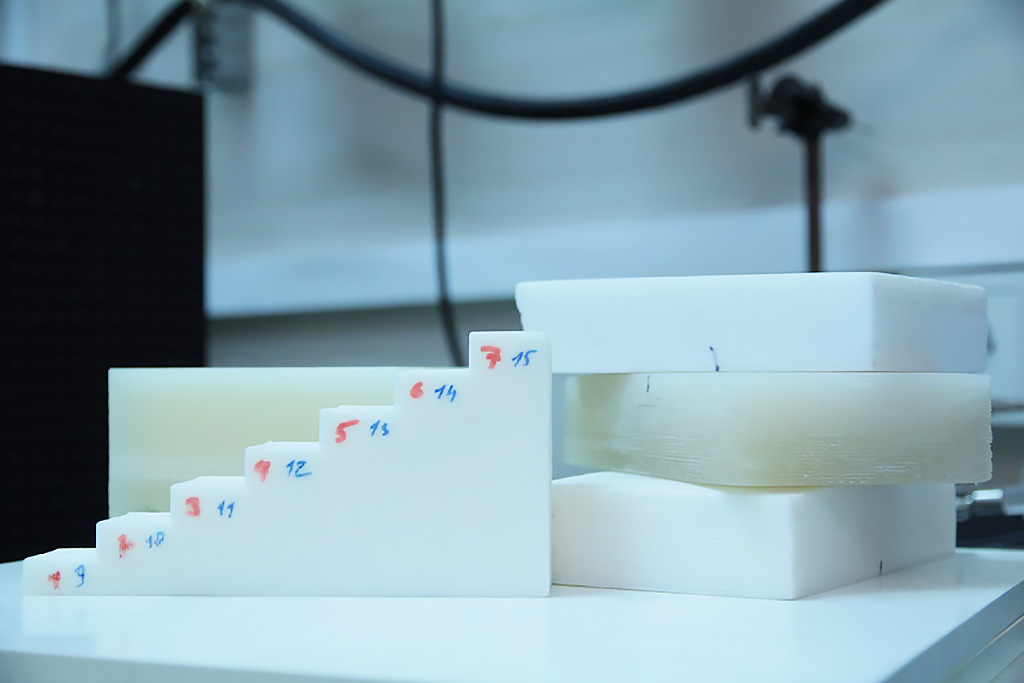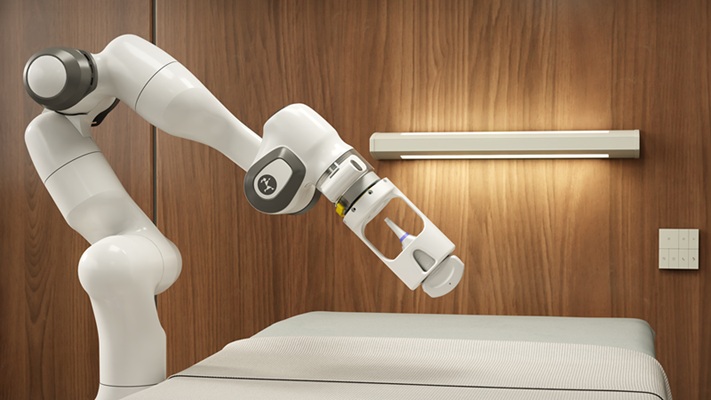3D Printed Plastics Could Replace Metallic Collimators
|
By MedImaging International staff writers Posted on 18 Nov 2019 |

Image: Plastic collimator samples made using 3D printing (Photo courtesy of TPU)
3D printing of plastic collimators for external beam radiation therapy (EBRT) could improve accuracy and reduce dose delivery and collimator manufacturing time, claims a new study.
In order to develop the plastic collimators, researchers at Tomsk Polytechnic University (TPU; Russia), Moscow City Oncology Hospital No. 62 (Russia), and University Hospital Hamburg-Eppendorf (UKE; Germany) first used a numerical model to study the capability of high impact polystyrene (HIS) and acrylonitrile butadiene styrene (ABS) plastics to absorb an electron beam, and the required thickness and manufacturing method needed for the printed collimator to completely absorb the EBRT dose.
They then used the plastics to manufacture the first products through the method of layer-by-layer fused deposition modeling, using rapid prototyping. As the manufacturing process can affect crucial properties, such as material homogeneity (due to the presence of residual air-filled cavities), Monte Carlo simulations were used to determine electron depth dose distribution. The appropriate thickness for total absorption of 6 MeV electron beams was found tobe at least 4 cm, at least 8 cm for 12 MeV, and 11 cm for 20 MeV. The study was published in the August 2019 issue of Physica Medica.
“Metal collimators should be 1.6 cm thick to absorb the beam but, unlike metal, plastic does not have the same density and a number of other characteristics. We conducted a number of calculations and experiments to determine the thickness of a plastic product,” said senior author Sergei Stuchebrov, PhD, of the TPU Research School of High-Energy Physics. “For instance, we used special dosimeters, placed inside the plastic, to measure the depth distribution of the electron beam. The results can be used to further develop 3D printing procedures for medical electron beam profile formation.”
Collimators allow radiotherapy treatment (RT) flexibility in shielding organs-at-risk (OAR), while ensuring that the prescribed dose is delivered to the target. While in linear RT, a multi-leaf collimator (MLC) can be used to align the treatment field parallel to the radiation field and to the shape of the tumor, EBRT works from multiple directions, requiring fabrication of a patient-specific collimator using hand-crafted blocks.
Related Links:
Tomsk Polytechnic University
Moscow City Oncology Hospital No. 62
University Hospital Hamburg-Eppendorf
In order to develop the plastic collimators, researchers at Tomsk Polytechnic University (TPU; Russia), Moscow City Oncology Hospital No. 62 (Russia), and University Hospital Hamburg-Eppendorf (UKE; Germany) first used a numerical model to study the capability of high impact polystyrene (HIS) and acrylonitrile butadiene styrene (ABS) plastics to absorb an electron beam, and the required thickness and manufacturing method needed for the printed collimator to completely absorb the EBRT dose.
They then used the plastics to manufacture the first products through the method of layer-by-layer fused deposition modeling, using rapid prototyping. As the manufacturing process can affect crucial properties, such as material homogeneity (due to the presence of residual air-filled cavities), Monte Carlo simulations were used to determine electron depth dose distribution. The appropriate thickness for total absorption of 6 MeV electron beams was found tobe at least 4 cm, at least 8 cm for 12 MeV, and 11 cm for 20 MeV. The study was published in the August 2019 issue of Physica Medica.
“Metal collimators should be 1.6 cm thick to absorb the beam but, unlike metal, plastic does not have the same density and a number of other characteristics. We conducted a number of calculations and experiments to determine the thickness of a plastic product,” said senior author Sergei Stuchebrov, PhD, of the TPU Research School of High-Energy Physics. “For instance, we used special dosimeters, placed inside the plastic, to measure the depth distribution of the electron beam. The results can be used to further develop 3D printing procedures for medical electron beam profile formation.”
Collimators allow radiotherapy treatment (RT) flexibility in shielding organs-at-risk (OAR), while ensuring that the prescribed dose is delivered to the target. While in linear RT, a multi-leaf collimator (MLC) can be used to align the treatment field parallel to the radiation field and to the shape of the tumor, EBRT works from multiple directions, requiring fabrication of a patient-specific collimator using hand-crafted blocks.
Related Links:
Tomsk Polytechnic University
Moscow City Oncology Hospital No. 62
University Hospital Hamburg-Eppendorf
Latest Nuclear Medicine News
- Radiopharmaceutical Molecule Marker to Improve Choice of Bladder Cancer Therapies
- Cancer “Flashlight” Shows Who Can Benefit from Targeted Treatments
- PET Imaging of Inflammation Predicts Recovery and Guides Therapy After Heart Attack
- Radiotheranostic Approach Detects, Kills and Reprograms Aggressive Cancers
- New Imaging Solution Improves Survival for Patients with Recurring Prostate Cancer
- PET Tracer Enables Same-Day Imaging of Triple-Negative Breast and Urothelial Cancers
- New Camera Sees Inside Human Body for Enhanced Scanning and Diagnosis
- Novel Bacteria-Specific PET Imaging Approach Detects Hard-To-Diagnose Lung Infections
- New Imaging Approach Could Reduce Need for Biopsies to Monitor Prostate Cancer
- Novel Radiolabeled Antibody Improves Diagnosis and Treatment of Solid Tumors
- Novel PET Imaging Approach Offers Never-Before-Seen View of Neuroinflammation
- Novel Radiotracer Identifies Biomarker for Triple-Negative Breast Cancer
- Innovative PET Imaging Technique to Help Diagnose Neurodegeneration
- New Molecular Imaging Test to Improve Lung Cancer Diagnosis
- Novel PET Technique Visualizes Spinal Cord Injuries to Predict Recovery
- Next-Gen Tau Radiotracers Outperform FDA-Approved Imaging Agents in Detecting Alzheimer’s
Channels
Radiography
view channel
Routine Mammograms Could Predict Future Cardiovascular Disease in Women
Mammograms are widely used to screen for breast cancer, but they may also contain overlooked clues about cardiovascular health. Calcium deposits in the arteries of the breast signal stiffening blood vessels,... Read more
AI Detects Early Signs of Aging from Chest X-Rays
Chronological age does not always reflect how fast the body is truly aging, and current biological age tests often rely on DNA-based markers that may miss early organ-level decline. Detecting subtle, age-related... Read moreMRI
view channel
MRI Scans Reveal Signature Patterns of Brain Activity to Predict Recovery from TBI
Recovery after traumatic brain injury (TBI) varies widely, with some patients regaining full function while others are left with lasting disabilities. Prognosis is especially difficult to assess in patients... Read more
Novel Imaging Approach to Improve Treatment for Spinal Cord Injuries
Vascular dysfunction in the spinal cord contributes to multiple neurological conditions, including traumatic injuries and degenerative cervical myelopathy, where reduced blood flow can lead to progressive... Read more
AI-Assisted Model Enhances MRI Heart Scans
A cardiac MRI can reveal critical information about the heart’s function and any abnormalities, but traditional scans take 30 to 90 minutes and often suffer from poor image quality due to patient movement.... Read more
AI Model Outperforms Doctors at Identifying Patients Most At-Risk of Cardiac Arrest
Hypertrophic cardiomyopathy is one of the most common inherited heart conditions and a leading cause of sudden cardiac death in young individuals and athletes. While many patients live normal lives, some... Read moreUltrasound
view channel
Wearable Ultrasound Imaging System to Enable Real-Time Disease Monitoring
Chronic conditions such as hypertension and heart failure require close monitoring, yet today’s ultrasound imaging is largely confined to hospitals and short, episodic scans. This reactive model limits... Read more
Ultrasound Technique Visualizes Deep Blood Vessels in 3D Without Contrast Agents
Producing clear 3D images of deep blood vessels has long been difficult without relying on contrast agents, CT scans, or MRI. Standard ultrasound typically provides only 2D cross-sections, limiting clinicians’... Read moreGeneral/Advanced Imaging
view channel
New 3D Imaging System Addresses MRI, CT and Ultrasound Limitations
Medical imaging is central to diagnosing and managing injuries, cancer, infections, and chronic diseases, yet existing tools each come with trade-offs. Ultrasound, X-ray, CT, and MRI can be costly, time-consuming,... Read more
AI-Based Tool Predicts Future Cardiovascular Events in Angina Patients
Stable coronary artery disease is a common cause of chest pain, yet accurately identifying patients at the highest risk of future heart attacks or death remains difficult. Standard coronary CT scans show... Read moreImaging IT
view channel
New Google Cloud Medical Imaging Suite Makes Imaging Healthcare Data More Accessible
Medical imaging is a critical tool used to diagnose patients, and there are billions of medical images scanned globally each year. Imaging data accounts for about 90% of all healthcare data1 and, until... Read more
Global AI in Medical Diagnostics Market to Be Driven by Demand for Image Recognition in Radiology
The global artificial intelligence (AI) in medical diagnostics market is expanding with early disease detection being one of its key applications and image recognition becoming a compelling consumer proposition... Read moreIndustry News
view channel
GE HealthCare and NVIDIA Collaboration to Reimagine Diagnostic Imaging
GE HealthCare (Chicago, IL, USA) has entered into a collaboration with NVIDIA (Santa Clara, CA, USA), expanding the existing relationship between the two companies to focus on pioneering innovation in... Read more
Patient-Specific 3D-Printed Phantoms Transform CT Imaging
New research has highlighted how anatomically precise, patient-specific 3D-printed phantoms are proving to be scalable, cost-effective, and efficient tools in the development of new CT scan algorithms... Read more
Siemens and Sectra Collaborate on Enhancing Radiology Workflows
Siemens Healthineers (Forchheim, Germany) and Sectra (Linköping, Sweden) have entered into a collaboration aimed at enhancing radiologists' diagnostic capabilities and, in turn, improving patient care... Read more



















